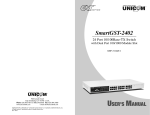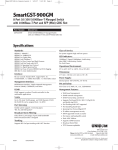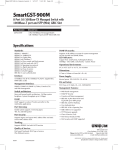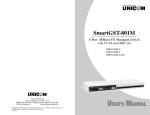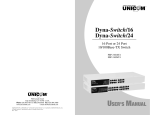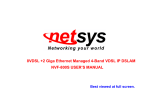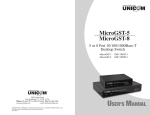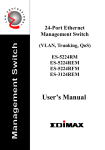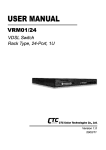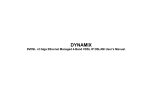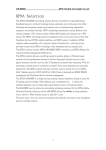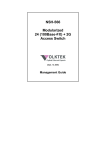Download UNICOM Electric SmartGST-2402M Network Card User Manual
Transcript
UNICOM SmartGST-2402M Introduction Unicom’s new 24 Port SmartGST-2402M is a high-speed, professional-grade managed Fast Ethernet switch that provides wire-speed, a Fast Ethernet switching technology that allows high-performance, low-cost connections up to Full-Duplex, 100Mbps Fast Ethernet networks. The SmartGST-2402M switch is a store-andforward device that offers low latency for high-speed networking and features an expansion slot for an optional 1000Base-T/SX/LX module. It is ideal for workgroup, department, or backbone environments. Figure 1-1. The SmartGST-2402M Features ■ Conforms to IEEE 802.3, 802.3ab, 802.3ad, 802.3u, 802.3z, 802.1d, 802.1p, 802.1Q, and 802.3x standards ■ 24 auto-sensing 10/100Mbps Ethernet RJ-45 ports ■ Automatic MDI/MDIX crossover for 10Base-T and 100Base-TX ports ■ One Expansion Slot for 2 Port 1000Base-SX, 1000Base-LX, or 1000Base-T modules ( Optional ) ■ N-way Auto-negotiation supported ■ Back-Pressure-Base flow control on Half-duplex link mode ■ Pause-Frame-Base flow control on Full-duplex link mode ■ Store-and-forwarding switching architecture for abnormal packet filtering ■ Back Plane 8.8G 1 ™ series SmartGST-2402M 24 Port 10/100Base-TX Switch Fully Managed with VLAN and a Gigabit Fiber Optic Slot GEP-60124T 908 Canada Court City of Industry, CA 91748 U.S.A. Phone: 626.964.7873 or 800.346.6668 Fax: 626.964.7880 www.unicomlink.com e-mail: [email protected] ©UNICOM 2004. UNICOM and “A Network Systems Solution” are trademarks of UNICOM Electric, Inc. All rights reserved. Specifications subject to change without notice. Rev: 11.04 USER’S MANUAL www.unicomlink.com UNICOM ■ Full wire speed forwarding rate ■ 6K-entry MAC address table ■ 3Mbits for shared packet buffer ■ LED-indicators: Per unit: Power Per UTP Port: 100M, LK/ACT, Full/Collision Per Gigabit Module: UTP, LK/ACT, 100, 1000, Full Fiber, LK/ACT ■ 19” Standard Rack-mounted size Software Features Management Telnet management, Web Management, In Band Local Console (RS-232) RFC Standard RFC 1157 SNMP, RFC 1213 MIB II, Bridge MIB, RFC 1643 ETHERNET LIKE, RFC 1493 BRIDGE MIB, RFC 1751 RMON 1, RFC 1215 Trap Software Upgrade TFTP and Console firmware upgrade Port Trunk Support IEEE802.3ad with LACP function and provide 7 Trunk group of 4 member ports within 26 ports. Spanning Tree IEEE802.1d spanning Tree, IEEE802.1s rapid spanning Tree, IEEE802.1w multiple spanning tree VLAN Port Based VLAN IEEE802.1Q Tag VLAN and GVRP supported IEEE802.1v Protocol VLAN VLAN groups up to 256, VLAN ID up to 4095 QoS Policy Supports 8 priority levels ID for two priority queue Class of Service Support IEEE802.1p Priority. Supports First Come First service, All High before Low, WRR for High or low weight. Port Based Priority Support 3 setting, Disable, Low and High priority. When set to Disable, the income packet will follow QoS policy. Otherwise, the packet will follow port priority setting to High/Low queue. 2 UNICOM SmartGST-2402M IGMP IGMP Snooping for Multi-Media application, IGMP group supports 256 groups Port Security MAC address filter for ingress an egress packet Static MAC address Lock for Source address. Port Mirror Global System support 3 mirroring type RX, TX and both packet. The maximum of mirror entries up to 25. Bandwidth Control Per port support Bandwidth control. Per level 100K. 802.1x Support IEEE802.1x user authentication and can report to Radius Server. DHCP Support DHCP Client Broadcast Storm Disable, 5%, 10%, 15% , 20%, 25% Package Contents Unpack the contents of the SmartGST-2402M and verify them against the checklist below. ■ ■ ■ ■ ■ SmartGST-2402M ( Auto MDI/MDIX ) Power Cord Four Rubber Feet RS-232 cable User Guide SmartGST-2402M Managed Fast Ethernet Switch Rack-mounting Kit Rubber Feet Power Cord User Guide Figure 1-2. Package Contents IF any item is missing or damaged, please contact your local dealer or reseller for service. 3 www.unicomlink.com UNICOM Ethernet Switching Technology Ethernet Switching Technology dramatically boosted the total bandwidth of a network, eliminated congestion problems inherent with Carrier Sense multiple access with Collision Detection ( CSMA/CD ) protocol, and greatly reduced unnecessary transmissions. This revolutionized networking. First, by allowing two-way, simultaneous transmissions over the same port ( Full-duplex ), which essentially doubled the bandwidth. Second, by reducing the collision domain to a single switch-port, which eliminated the need for carrier sensing. Third, by using store-and-forward technology to inspect each packet and intercept corrupt or redundant data. Switching eliminated unnecessary transmission that slows the network. Addresslearning was employed to replace the inefficient receiving port. Auto-negotiation regulates the speed and duplex of each port, based on the capability of both devices. Flow-control allows transmission from a 100Mbps node to a 10Mbps node without loss of data. Auto-negotiation and flow-control may need to be disabled for some network applications involving legacy equipment. Disabling the auto-negotiation is accomplished by fixing the speed or duplex of a port. Ethernet Switching Technology supplied higher performance at lower costs than other solutions. Wider bandwidth, no congestion, and the reduction in traffic is why switching is replacing expensive routers and inefficient hubs as the ultimate networking solution. Switching brings a new way of thinking to networking. Hardware Description This Section describes the hardware of the SmartGST-2402M and gives a physical and functional overview of this Switch. The physical dimensions of the SmartGST-2402M are: 440mm x 160mm x 44mm ( LxWxH) Front Panel The Front Panel of the SmartGST-2402M consists of twenty-four 10/100Base-TX RJ-45 ports ( Auto MDI/MDIX ) and one Expansion slot. The LED Indicators are also located on the front panel of the Switch. 4 UNICOM SmartGST-2402M 10/100Base-TX RJ-45 ports LED Indicators Module slot Console Port 2 4 6 8 10 12 14 16 18 19 22 24 1 3 5 7 9 11 13 15 17 19 21 23 Figure 2-1. The Front panel of SmartGST-2402M RJ-45 Ports ( Auto MDI/MDIX ): Twenty-four 10/100 N-way auto-sensing connections for 10Base-T or 100Base-TX. Module Slot: There are three types of 2-port expansion Module available for the SmartGST-2402M, ( 1000Base-SX, 1000Base-LX, 1000Base-T ). LED Indicators The LED Indicators give real-time information of systematic operation status. The following table provides descriptions of LED status. Figure 2-2. LED indicators LED Status Green Description Power On Power Off LNK/ACT Green The port is connecting with the device. Blinks The port is receiving or transmitting data. Off FDX/COL Power is not connected Yellow No device attached. The port is operating in Full-duplex mode. 5 www.unicomlink.com UNICOM Off No device attached or in half-duplex mode. Table 2-1. The Description of LED Indicators Rear Panel The 3-pronged power plug and ventilation fan are located at the rear Panel of the SmartGST-2402M as shown in Figure 2-2. The Switch will work with AC in the range 100-240V AC, 50-60Hz. Figure 2-3. The Rear Panel of SmartGST-2402M Desktop Installation Set the Switch on a sufficiently large flat space with a power outlet nearby. The surface where you put your Switch should be clean, smooth, level and sturdy. Make sure there is enough clearance around the Switch to allow attachment of cables, power cord and allow air circulation. Attaching Rubber Feet A. Make sure mounting surface on the bottom of the Switch is grease and dust free. B. Remove adhesive backing from your Rubber Feet. C. Apply the Rubber Feet to each corner on the bottom of the Switch. These footpads can protect the Switch from shock and vibration. Figure 2-4. Attaching Rubber Feet to each bottom corner of the of the Switch 6 UNICOM SmartGST-2402M Rack-mounted Installation The SmartGST-2402M comes with a rack-mounting kit and can be mounted in an EIA standard sized, 19-inch Rack. The Switch can be placed in a wiring closet with other equipment. Perform the following steps to rack mount the switch: A. Align one bracket with the holes on one side of the switch and secure it with the smaller bracket screws. Then attach the remaining bracket to the other side of the Switch. Figure 2-4. Attach mounting brackets with screws B. After you’ve attached both mounting brackets, position the SmartGST-2402M in the rack by lining up the holes in the brackets with the appropriate holes on the rack. Secure the Switch to the rack with a screwdriver and the rack-mounting screws. Figure 2-5. Mount the SmartGST-2402M in a standard 19-inch Rack Note: For proper ventilation, allow about at least 4 inches ( 10 cm ) of clearance on the front and 3.4 inches ( 8 cm ) on the back of the Switch. This is especially important for enclosed rack installation. 7 www.unicomlink.com UNICOM Power On Connect the power cord to the power socket on the rear panel of the Switch. The other side of power cord connects to the power outlet. The internal power supply in the Switch works with AC in the voltage range 100-240VAC, frequency 50~60Hz. Check the power indicator on the front panel to see if power is properly supplied. Network Application This section provides you a few samples of network topology in which the Switch is used. The SmartGST-2402M is designed as a segment switch. With its large address table (6000 MAC addresses) and high performance, it is ideal for interconnecting networking segments. You can use the SmartGST-2402M to interconnect PCs, workstations, and servers to each other by connecting these devices directly to the Switch. The switch automatically learns node addresses, which are subsequently used to filter and forward all traffic based on the destination address. By using the Uplink feature, the Switch can connect with another switch or hub to interconnect each of your switched workgroups forming a larger switched network. Also you can also use the expansion port to connect switches for great distances. The distance between two switches via fiber cable can be up to 10 Kilometers (Gigabit LX port with Single Mode fiber). Small Workgroup The SmartGST-2402M can be used to create a small workgroup by directly connecting personal computers, servers, and printer servers. 8 UNICOM SmartGST-2402M Figure 3-1. Small Workgroup Application Segment Bridge In enterprise networks where large data broadcasts are constantly processed, this switch is perfect for department users connecting to the corporate backbone. In the illustration below, two Ethernet switches with PCs, a print server, and a local server attached, are both connected to the SmartGST-2402M. Each device in this network can communicate with the others through the SmartGST-2402M. Connecting servers to the Switch allows other users to access the server’s data. Figure 3-2 Department Bridge Application 9 www.unicomlink.com UNICOM Connecting to the Switch The Console port is a male DB-9 connector that enables connection of a PC or terminal for monitoring and configuring the Switch. Use the supplied RS-232 cable to connect a terminal or PC to the Console port. The Console configuration (out of band) allows you to set your Switch to enable a user at a remote console terminal to communicate with the Switch as if the remote terminal were directly connected to it. Console Management Login in the Console Interface Once you have connected the cable to the switch and the PC, turn on the PC and run a terminal emulation program or Hyper Terminal and configure its communication parameters to match the following default characteristics of the console port: Baud Rate: 9600 bps Data Bits: 8 Parity: none Stop Bit: 1 Control flow: None Figure 3-3. The settings of communication parameters After you have completed the parameter settings, press “OK“. 10 UNICOM SmartGST-2402M Main Menu Login 1. When the Login screen appears, press Enter 2. You can type user name and password to login. The default user name is “root” and the default password is “root ”. 4-1 Main Menu There are five options available: Status and Counters: Shows the status of the switch. Switch Static Configuration: Configure the switch. Protocol Related Configuration: Configure the protocol function. Reboot Switch: Restart the system or reset switch to default configuration. Logout: Exit the menu line program. <Control Key> The control keys in all menus are as follows: Tab: Move to the next item. Backspace: Move to the previous item. Enter: Select item. Space: Toggle selected item to next configure. 4-2. Status and Counters 11 www.unicomlink.com UNICOM You can press the Tab or Backspace key to choose an item and then the Enter key to select an item. 4-2-1. Port Status This page displays the status of every port Actions-> You can press the Tab or Backspace key to choose an item and the Enter key to select an item. <Quit>: Exit the port status page and return to previous menu. <Previous Page>: Display previous page. <Next page>: Display next page. 4-2-2. Port Counters The following information provides a view of the current status of the unit. 12 UNICOM SmartGST-2402M Actions-> You can press the Tab or Backspace key to choose an item and then the Enter key to select an item. <Quit>: Exit the page of port status and return to previous menu. <Refresh>: Set all counts to 0. <Previous Page>: Display previous page. <Next page>: Display next page. 4-2-3. System Information System Description: Display the name of the device. MAC Address: The unique hardware address assigned by manufacturer. Firmware Version: Display the switch’s firmware version. Hardware Version: Display the switch’s hardware version. Module Information: Display type of Module. 13 www.unicomlink.com UNICOM 4-3. Switch Static Configuration You can press the Tab or Backspace key to choose an item and then the Enter key to select an item. 4-3-1. Administration Configuration 14 UNICOM SmartGST-2402M 4-3-1-1. Device Information This page provides configuration of the device information. Actions-> <Edit>: Configure all items. When finished with configuration press Backspace to go back to action menu line. <Save>: Save all configured values. <Quit>: Exit the device information page and return to previous menu. 15 www.unicomlink.com UNICOM 4-3-1-2. IP Configuration Configuration of the IP setting. Actions-> <Edit>: Configure all items. When finished with configuration press ESC to go back to action menu line. <Save>: Save all configured values. <Quit>: Exit the IP configuration page and return to previous menu. Note: Always restart the device after finishing setup. 4-3-1-3. Change Username Use this page to change Web Management user name. 16 UNICOM SmartGST-2402M 4-3-1-4. Change Password Use this page to change Web Management user password. 4-3-2. Port Configuration This page can change all port statuses and configure the trunk group. Press the TAB key to select an item to configure and press SPACE to make a change. 1. State: Current port status. The port can be set to disable or enable mode. If the port setting is disable then it will not receive or transmit any packets. 2. Negotiation: Current auto negotiation setting status of each port. 3. Speed/Duplex: User can set each port for link speed and duplex mode. 4. FC / BP: User can set flow control function to enable or disable. FC (Flow control for full duplex link mode), BP (Backpressure for half duplex mode) 5. Bandwidth In/ Out: For per port packet transmission rate control. Per port level is 100Kbps. It supports individual control method of TX and RX. 6. Priority: Set port to high or low priority. 7. Security: Enable or disable port security function. 17 www.unicomlink.com UNICOM Actions-> <Quit>: Exit the port configuration page and return to previous menu. <Edit>: Configure all items. When finished with configuration press ESC to go back to action menu line. <Save>: Save all configured values. Before you leave this session, please execute this command or you will lose all changes. <Previous Page>: Return to previous page. <Next page>: Go to next page. 4-3-3. Port Trunk Configuration Use this page to configure trunk group. Press TAB key to select item and SPACE key to make change. Actions-> <Quit>: Exit the port configuration page and return to previous menu. 18 UNICOM SmartGST-2402M <Edit>: Configure all items. When finished with configuration press ESC to go back to action menu line. <Save>: Save all configured values. Before you leave this session, please execute this command or you will lose all changes. 4-3-4. Port Mirroring Configuration Port Mirroring is a method of monitoring traffic in switched networks. Traffic through ports can be monitored by one specific port. All traffic going in or out of monitored ports will be duplicated into monitoring port. Press the Space key to change configuration of each item. Mirroring state: Mirror mode for TX packet only, RX packet only, or both packets. Analysis port: Set the destination port of the mirroring packet. All of the packets of mirroring port will be duplicated and sent to Analysis port. Use the SPACE key to select. Actions-> <Quit>: Exit the port configuration page and return to previous menu. <Edit>: Configure all items. When finished with configuration press ESC to go back to the action menu line. <Save>: Save all configured values. Before you leave this session, please execute this command or you will lose all changes. <Previous Page>: Return to previous page. <Next page>: Go to next page. 19 www.unicomlink.com UNICOM 4-3-5. VLAN Configuration This is where you can configure the VLAN mode as port-based VLAN, 802.1Q VLAN, or disabled VLAN. NOTE: After changing the VLAN mode, you must reset the switch before changes will take effect. 4-3-5-1. VLAN Configure VLAN Mode: There are three options available: Port based VLAN, IEEE802.1Q Tag based VLAN, and VLAN disabled. VLAN (Port VID: 1 ~ 255): Type the PVID. Acceptable Frame type: It matches the Ingress Filtering Rule 1 on the Web. It forwards only packets with VIDs matching this port°¶ s configured VID. Press Space to choose whether to forward or drop the frames that do not match the VID for this port°¶ s configured VID. Ingress Filter: It matches the Ingress Filtering Rule 2 on the web. It drops untagged frames. Press Space to choose to drop and forward of untagged frames. 20 UNICOM SmartGST-2402M 4-3-4-2. Create a VLAN Group _Create Port-Based VLAN Create a port-based VLAN and add member/nonmember ports to it. Select <Edit>. VLAN Name: Type a name for the new VLAN. Group ID: Type the VLAN group ID. The group ID range is 1 ~ 4096. Member: Press Space key to choose VLAN member. There are two choices: Member: The port is a member port. NO: The port is NOT a member port. Press “ESC” to go back to the action menu line. Select <Save> to save all configured values. NOTE: If a trunk group exists, you can see it (ex: TRK1, TRK.) after port 26 and configure it whether it is a member of the VLAN or not. 21 www.unicomlink.com UNICOM _Create 802.1Q VLAN Create an 802.1Q VLAN and add tagged /untagged member ports to it. 1. Select <Edit>. 2. VLAN Name: Type a name for the new VLAN. 3. VLAN ID: Type a VID (between 1~4096). The default is 1. There are 256 VLAN groups available. 4. Protocol VLAN: Press the Space key to choose protocol type. 5. Member: Press the Space key to choose a VLAN member. There are three choices: a. UnTagged: this port is a member port of this VLAN group and outgoing frames are NO VLAN-Tagged frames. b. Tagged: This port is a member port of this VLAN group and outgoing frames are VLAN-Tagged frames. c. No: The port is NOT a member of this VLAN group. 6. Press ESC to go back to the action menu line. 7. Select <Save> to save all changes. 22 UNICOM SmartGST-2402M NOTE: If a trunk group exists, you can see it (ex: TRK1, TRK.) after port 26 and configure it whether it is a member of the VLAN or not. Actions-> <Quit>: Exit this page and return to previous menu. <Edit>: Configure all items. When finished with configuration press ESC to go back to the action menu line. <Save>: Save all configured values. <Previous Page>: Return to previous page. <Next page>: Go to next page. 4-3-4-3. Edit / Delete a VLAN Group This page allows users to edit or delete a VLAN group. 1. Press <Edit> or <Delete> item. 2. Choose the VLAN group that you want to edit or delete and then press Enter. 3. Users can modify the VLAN item protocol and mark the member ports as either tagged or un-tagged. Member ports can also be removed from this VLAN group. 4. After editing or deleting VLAN, press <Save> to save all configured values. NOTE: 1. The VLAN Name and VLAN ID cannot be modified. 2. The default VLAN cannot be deleted. 23 www.unicomlink.com UNICOM 4-3-4-4. Groups Sorted Mode In this page, users can select the VLAN groups sorting mode: (1) sorted by name or (2) sorted by VID. In the Edit/Delete a VLAN group, this page will be displayed. In the Edit/Delete a VLAN Group page, the result of sorted by VID. 24 UNICOM SmartGST-2402M 4-3-5. Priority Configuration There are 0~7 priority levels that can be set to high or low priority. 1. Select <Edit>. 2. Press the Space key to select the priority level mapping to high or low queue. 3. High/Low Queue Service Ration: User can select the ratio of high and low priority packets. 4. Press “ESC” to go back to the action menu line. 5. Select <Save> to save all configured values. 4-3-6. MAC Address Configuration 25 www.unicomlink.com UNICOM 4-3-6-1. Static MAC Address When you add a static MAC address, it remains in the switch's address table, regardless of whether the device is physically connected to the switch or not. This saves the switch from having to re-learn a device's MAC address when the disconnected or powered-off device is active on the network again. On this page, a user can add, modify, or delete a static MAC address. Add static MAC address 1. Press <Add> --> <Edit> to add a static MAC address. 2. MAC Address: Enter the MAC address to and from which the port should permanently forward traffic, regardless of the device’s network activity. 3. Port num: press <Space> to select the port number. 4. VLAN ID: If tag-based (802.1Q) VLAN is set up on the switch, static addresses are associated with individual VLANs. Type the VID to associate a VLAN with a specific MAC address. 5. Press ESC to go back to the action menu line and then select <Save> to save all configured values. Edit static MAC address 1. Press <Edit>. 2. Choose the MAC address that you want to modify and press Enter. 3. Press <Edit> to modify all the items. 4. Press ESC to go back to the action menu line and then select <Save> to save all configured values. Delete static MAC address 1. Press the <Delete>. 2. Choose the MAC address that you want to delete and then press Enter. 3. Pressing <Enter> once will complete deletion in delete mode. 26 UNICOM SmartGST-2402M 4-3-6-2. Filtering MAC Address Edit Filtering MAC address 1. Press <Edit> to modify a static Filtering address. 2. Choose the MAC address that you want to modify and then press Enter. 3. Press <Edit> key to modify all the items. 4. Press ESC to go back to the action menu line and then select <Save> to save all configured values. Delete Filtering MAC address 1. Press <Delete> key to delete a Filtering MAC address. 2. Choose the MAC address that you want to delete and then press Enter. 3. After deleting a Filtering MAC address, press <Save> to complete the deleting operation. 4-3-7. Misc. Configuration MAC Address Aging Time: MAC address table refresh time setting. Broadcast Storm Filter Mode: 5%, 10%, 15%, 20%, 25%, N/A. The port will be blocked because the broadcast packet is over the percentage of traffic. Max Bridge Transmit Delay Bound: On or Off Low Queue Max Delay Time: 1 to 255 Collision Retry Forever: Disable or Enable Hash Algorithm: Provide CRC or Direct Map IFG compensation: Disable or Enable 27 www.unicomlink.com UNICOM 4-3-7-1. MAC Address Aging Time Type the number of seconds that an inactive MAC address remains in the switch’s address table. The valid range is 0 or 300~765 seconds. Default is 300 seconds. Actions-> <Edit>: Configure all items. When finished with configuration, press ESC to go back to action menu line. <Save>: Save all configured values. <Quit>: Exit this page and return to previous menu. 4-3-7-2.Broadcast Storm Filter Mode This page is for configuring broadcast storm control. 1. Press <Edit> to configure the broadcast storm filter mode. 2. Press Space key to choose the threshold value. The valid threshold values are 5%, 10%, 15%, 20%, 25%, and N/A. 4-3-7-3. Max bridge transmit delay bound 1. Max bridge transmit delay bound: Limits the packet queuing time in the switch. If enabled, any packets exceeding queue will be dropped. The valid values are 1 sec, 2 sec, 4 sec and off. The default is off. 2. Low Queue Delay Bound: Limits the low priority packet queuing time in switch. If the low priority packets stay in the switch over the Low Queue Max Delay Time, they will be automatically sent. Press Space key to enable or disable this function. 3. Low Queue Max Delay Time: Sets the time that low priority packets will be queued in the switch. The valid range is 1~255 ms. NOTE: To ensure proper performance, make sure Max bridge transit delay bound control is enabled before enabling Low Queue Delay Bound. 28 UNICOM SmartGST-2402M 4-3-7-4. Collision Retry Forever Collisions Retry Forever: Disable – In half duplex, collision will retry 48 times and then drop frame. Enable – In half duplex, collision will retry indefinitely. 4-3-7-5. Hash Algorithm This Hash Algorithm is for hardware maintenance with MAC table calculations. 4-3-7-6. IFG Compensation 4-4. Protocol Related Configuration 4-4-1.STP 29 www.unicomlink.com UNICOM 4-4-1-1. STP Enable This page enables or disables the Spanning Tree function. Press the Space key to select enable or disable. 4-4-1-2. System Configuration 1. You can view spanning tree information about the Root Bridge on the left. 2. On the right, new values for the STP parameter can be set. 30 UNICOM SmartGST-2402M 4-4-1-3. Perport Configuration 1. State: Display spanning tree status for the switch: whether each port is forwarding or blocking. 2. Select <Edit>. 3. PathCost: Specifies the path cost of the port that the switch uses to determine which ports are the forwarding ports. 4. Priority: This means port priority. You can make it more or less likely to become the root port. 5. Press ESC to go back to the action menu line. 6. Select <Save> to save all configure values. 7. On the action menu line you can press <Next Page> to configure port 9 ~ port 26 8. Press <Previous Page> to return to last page. 31 www.unicomlink.com UNICOM 4-4-2. SNMP Use this page to define management stations as trap managers and to enter SNMP community strings. User can also define a name, location, and contact person for the switch. 4-4-2-1. SNMP System Options 1. 2. 3. 4. 5. 6. Press <Edit>. System Name: Type a name to be used for the switch. System Contact: Type the name of the contact person or organization. System Location: Type the location of the switch. Press ESC to go back to the action menu line. Press <Save> to save configured values. 32 UNICOM SmartGST-2402M 4-4-2-2.Community Strings Use this page to enter SNMP community strings. 1. Community Name: Type the name of the current strings. 2. Write Access: Enable privileges as read only or read/write. a. Read only: Enables requests accompanied by this string to display MIB-object information. b. Read/write: Enables requests accompanied by this string to display MIB-object information and to set MIB objects. Actions-> <Add>: Create a community string. <Edit>: Configure all items. When finished with the configuration, press ESC to go back to the action menu line. <Delete>: Delete a community string. After item is deleted, press <Save> to complete the deletion operation. <Save>: Save all configured values. <Quit>: Exit this page and return to previous menu. _Add Community Name 1. Press <Add> <Edit> key. 2. Community Name: Type the community name. 3. Write Access: Press <Space> to select rights as restricted or unrestricted. _Edit Community Name 1. Press <Edit> to choose the item that you want to modify and then press Enter. 2. Community Name: Type the new name. 3. Write Access: Press <Space> to select rights as restricted or unrestricted. 33 www.unicomlink.com UNICOM _Delete Community Name 1. Press <Delete> key. 2. Choose the community name that you want to delete and then press Enter. 3. Pressing <Enter> once will complete deletion operation. 4-4-2-3.Trap Managers A trap manager is a management station that receives traps, the system sends alerts generated by the switch. If no trap manager is defined, no traps are issued. Create a trap manager by entering the IP address of the station and a community string. 34 UNICOM SmartGST-2402M Actions-> <Add>: Create a trap manager. <Edit>: Modify all items. Press ESC when finished with configuration to go back to the action menu line. <Delete>: Delete a trap manager. After deleting an item, press <Save> to complete the operation. <Save>: Save all configured values. <Quit>: Exit this page and return to previous menu. _Add the trap manager 1. 2. 3. 4. Press <Add> <Edit> to add the trap manager. IP: Type the IP address. Community Name: Type the community name. Press ESC to go to actions line, press <Save> to save all configured values. _Delete trap manager 1. Press < Delete >. 2. Choose the trap manager that you want to delete and then press Enter. 3. Pressing <Enter> once will complete deletion operation. 4-4-4 IGMP/GVRP This page enables or disables the GVRP (GARP VLAN Registration Protocol) support. Press Space to choose Enabled / Disabled. Actions-> <Edit>: Configure all items. Press Space to choose Enable or Disable mode. When finished, press ESC to go back to the action menu line. <Save>: Save all configured values. <Quit>: Exit this page and return to previous menu. 35 www.unicomlink.com UNICOM 4-4-3. LACP This page can configure and view the LACP status. 4-4-3-1.Working Ports Setting 1. Group ID: There are seven configurable Trunking groups. Choose the “Group ID” and click “Get”. 2. LACP: Press Space key to enable or disable LACP (Link Aggregation Control Protocol) support. If enabled, the group is a LACP static trunking group. If disabled, the group is a local static trunking group. All ports support LACP dynamic trunking groups. If connecting to another device that also supports LACP, the LACP dynamic trunking group will be automatically created. 3. Work Ports: This allows a maximum of four ports to be connected simultaneously. In a LACP static trunking group, the excess ports are on standby and able to aggregate if and when the work ports fail. In a local static trunking group, the number must be the same as the group member ports. NOTE: Before setting LACP support, you must set trunk group in Port / Trunk Configuration. 36 UNICOM SmartGST-2402M Actions-> <Edit>: Configure all items. When finished with configuration, press ESC to go back to action menu line. <Save>: Save all configured values. <Quit>: Exit this page and return to previous menu. 4-4-3-2. LACP State Activity Active: The port automatically sends LACP protocol packets. Passive: The port does not automatically send LACP protocol packets and responds only if it receives LACP protocol packets from the opposite device. 37 www.unicomlink.com UNICOM Actions-> <Edit>: Configure all items. Finished configure press “ESC” to go back action menu line. <Save>: Save all configure value. <Quit>: Exit this page and return to previous menu. 4-4-3-3.LACP Status When you setting up a trunking group, you can see relationship information here. Actions-> <Quit>: Exit this page and return to previous menu. <Previous Page>: Return to previous page to view. <Next page>: Go to next page to view. 4-4-5. 802.1X 38 UNICOM SmartGST-2402M 4-4-5-1. 802.1X Enable Press “Space” to Enable/Disable Actions-> <Quit>: Exit this page and return to previous menu. <Previous Page>: Return to previous page to view. <Next page>: Go to next page to view. <Edit>: Configure all items. Press the Space key to choose Enable or Disabled mode. When finished with configuration, press “ESC” to go back action menu line. 39 www.unicomlink.com UNICOM 4-4-5-1. System Configuration When enabling the IEEE 802.1X function, all parameters can be configured. 1. Radius Server IP: Set the Radius Server IP address. 2. Shared Key: Set an encryption key to use during authentication sessions with the specified radius server. This key must match the encryption key used on the Radius Server. 3. NAS Identifier: Set the identifier for the radius client. 4. Server Port: Set the UDP destination port for authentication requests to the specified Radius Server. 5. Accounting Port: Set the UDP destination port for accounting requests to the specified Radius Server. 40 UNICOM SmartGST-2402M 4-4-5-2. Per Port Configuration State provides Disable, Accept, Reject and Authorize options. Press the Space key to change state. 4-4-5-3. Miscellaneous Configuration 1. Quiet period: Set the period during which the port doesn’t try to acquire a supplicant. 2. Tx period: Set the period the port waits to retransmit next EAPOL PDU during an authentication session. 3. Supplicant timeout: Set the period of time the switch waits for a supplicant response to an EAP request. 4. Server timeout: Sets the period of time the switch waits for a server response to an 41 www.unicomlink.com UNICOM authentication request. 5. Reauthorize Maximum: Sets the number of authentication attempts that must timeout before authentication fails and the authentication session ends. 6. Reauthorize period: Sets the period of time after which clients connected must be re-authenticated. 4-5. Reboot Switch 4-5-1. Factory Default Reset switch to default configuration. Press “Y” and switch will load default setting. After you’re finished loading default setting, switch will automatically reboot. Default: Reset switch to default configuration. Restart: Reboot the switch for software reset. 4-5-2. System Reboot Reboot the switch for software reset. 42 UNICOM SmartGST-2402M 4-5-3. TFTP Update Firmware This page provides the updating of firmware, restoration of the EEPROM value, or the uploading of the current EEPROM value. 4-5-3-1. TFTP Update Firmware How to update TFTP firmware. 1. 2. 3. 4. 5. 6. 7. Start the TFTP server and copy firmware update version image file to TFTP server. Press <Edit> on this page. TFTP Server IP: Type the IP of the TFTP server. Firmware File Name: Type the image file name. Press “ESC” to go to the action line. Press the <Save> key. The image file will start to download. Once it is downloaded, you’re finished. 43 www.unicomlink.com UNICOM 8. Restart switch. 4-5-3-2. Restore TFTP Configuration This page shows how to restore the EEPROM value and save an image file from a TFTP server. 1. 2. 3. 4. 5. 6. 7. Start the TFTP server. Press <Edit> on this page. TFTP Server IP: Type the IP of TFTP server. Restore File Name: Type the image file name. Press “ESC” to go to the action line. Press the <Save> key. The image file will start to download. Restart switch. 44 UNICOM SmartGST-2402M 4-5-3-3. TFTP Backup Configuration Here you can save the current EEPROM value to an image file. Then go to the update configuration page to restore the EEPROM value. 1. 2. 3. 4. 5. 6. 7. Start the TFTP server. Press <Edit> on this page. TFTP Server IP: Type the IP of TFTP server. Backup File Name: Type the image file name. Press “ESC” to go to action line. Press the <Save> key. The image file will start to download. Restart switch. 4-6. Xmodem Upgrade 1. Press the X key to start upgrading for Xmodem. 2. First, disconnect terminal and modify baud rate to 57,600bps, then reconnect. 45 www.unicomlink.com UNICOM 3. 4. 5. Select “send file" under the "transfer" menu from the menu bar. Press the "browse" button to select the path. Select "1K Xmodem" for protocol and press the "Send" button. 6. After successfully upgrading the new firmware, re-modify the baud rate to 9600bps. 5. Web-Based Management This section introduces the configuration and functions of the Web-Based management feature. About Web-based Management Inside the CPU board of the switch, there exists an embedded HTML web site residing in flash memory. It offers advanced management features and allow users to manage the switch from anywhere on the network through a standard browser such as Microsoft Internet Explorer. 46 UNICOM SmartGST-2402M The Web-Based Management supports Internet Explorer 6.0 for Windows. It is based on Java Applets with an aim to reduce network bandwidth consumption, enhance access speed, and presents easy navigation. Note: By default, IE5.0 or later version does not allow Java Applets to open sockets. The user has to explicitly modify the browser setting to enable Java Applets to use network ports. System Login 1. Start Internet Explorer. 2. Type “http://” plus the IP address of the Modular Switch in the Location or Address field. Press Enter. 3. The Password screen appears. 4. Type user name and password. The default is “ root ” for User name and “root” for Password. 5. Press “Enter” or Click ”OK”. The Home Screen of the Web-based management appears. Web Management Function 1. The default values for the switch are as follows: If you need to change the IP address the first time you login, you can use the Console Mode to modify it here. IP Address: 192.168.16.1 Subnet Mask: 255.255.255.0 Default Gateway: 192.168.16.254 User Name: root Password: root 2. Type in http://192.168.16.1, and then enter the user name and password as above. 47 www.unicomlink.com UNICOM 5-1. Web Management Overview 5-2. Port status This page displays all port status. 1. State: Displays port status, disable or enable. Unlink will be treated as disabled. 2. Link Status: Down is “No Link”, UP is “Link”. 3. Auto Negotiation: Displays the auto negotiation mode: Auto-Force or Nway-force. 4. Speed status: Displays 1000Mbps, 100Mbps, or 10Mbps speed. Ports 1 - 24 are 10/100Mbps and Ports 25 - 26 are 10/100/1000Mbps. 5. Duplex status: Displays full-duplex or half-duplex mode. 6. Flow Control: Full: Displays flow control status as enabled or disabled in full mode. Half: Displays backpressure as enabled or disabled in half mode. 7. Rate Control: Displays the rate control setting. Ingr: Displays the effective port ingress rate of the user setting. Egr: Displays the effective port egress rate of the user setting. 8. Priority: Displays whether port static priority status is High, Low, or disabled. 9. Port Security: Displays whether port security is enable or disabled. 48 UNICOM SmartGST-2402M 10. Config: Displays the state of the user setting. 11. Actual: Displays the negotiation result. User can see a single port counter as follows 49 www.unicomlink.com UNICOM 5-3. Port Statistics The following information provides a view of the current status of the unit. Press “Reset” button to clear all counts. 5-4. Administrator There are many management functions available such as: IP address Switch settings Console port information Port controls Trunking Filter database VLAN configuration Spanning tree Port Mirroring SNMP Security Manager TFTP Update Firmware Configuration Backup Reset system Reboot 5-4-1. IP Address 1. 2. User can configure the IP Settings with a new value and then click Apply. You must reset the switch for the changes to take effect. 50 UNICOM SmartGST-2402M 5-4-2. Switch Setting 5-4-2-1.Basic Description: Displays the name of device type. MAC Address: The unique hardware address assigned by the manufacturer (default) Firmware Version: Displays the switch’s firmware version. ASIC Version: Displays the switch’s Hardware version. PCBA version: Displays the board number. Serial number: Displays the serial number assigned by the manufacturer. 5-4-2-2. Advanced and Miscellaneous Setting MAC Address Entry Age-out Time: Type the number of seconds that an inactive MAC address remains in the switch's address table. The valid range is 300~765 seconds. 51 www.unicomlink.com UNICOM Default is 300 seconds. Max bridge transmit delay bound control: Limits the packet queuing time in the switch. If enabled, any packets exceeding queue will be dropped. The valid values are 1sec, 2 sec, 4 sec, and off. Enable Low Queue Delay Bound: Limits the low priority packet queuing time in the switch. If the low priority packets stay in the switch over the Max Delay Time, they will automatically be sent. The valid range is 1~255 ms. NOTE: Make sure that “Max bridge transit delay bound control” is enabled before enabling “Delay Bound”. Broadcast Storm Filter: To configure broadcast storm control, enable it and set the upper threshold for individual ports. The threshold is the percentage of the port's total bandwidth used by broadcast traffic. When broadcast traffic for a port rises above the threshold you set, broadcast storm control becomes active. The valid threshold values are 5%, 10%, 15%, 20%, 25% and off. Priority Queue Service settings: First Come First Service: The sequence of packets sent depends on their arrival order. All High before Low: All high priority packets are sent before low priority packets. WRR (Weighted Round Ratio): Selects the preference given to packets in the switch's 52 UNICOM SmartGST-2402M high-priority queue. These options represent the number of high priority packets sent before one low priority packet is sent. For example, 5 High: 2 Low means that the switch sends 5 high priority packets before sending 2 low priority packets. QoS Policy: High Priority Levels: 0~7 priority level can be assigned to the high or low queues. 5-4-2-3 Miscellaneous Setting Collisions Retry Forever: Disable –in case of collisions in half duplex, switch will retry 48 times and then drop frame. Enable – in case of collisions in half duplex, switch will retry indefinitely. 802.1x Protocol: Enable or disable 802.1x protocol. Hash Algorithm: CRC Hash or Direct Map for MAC address learning algorithm IFG Compensation: Internal Packet Gap time compensation configuration: Enable or Disable. IGMP Query Mode: Recognizes different queries from clients or servers to decide which Query will be the first priority. The modes are: a. Auto Mode: Chooses the switch that has the smallest IP address to be set for the IGMP Query mode. b. Enable Mode: Enables the switch to be the IGMP Querier. c. Disable Mode: Disables all other switches from being the IGMP Querier. IGMP Theory of Operation The following three topologies detail how IGMP Query works and can be configured within a network: Auto Mode should be enabled when the router’s IP address is smaller than other switches in the subnet. 53 www.unicomlink.com UNICOM IGMP should be enabled when the router’s IP address is not smaller than other switches in the subnet. This switch supports IGMP protocol but IGMP must be enabled and the Router must be the Querier. The following topology must be set when the IP address of the switch is not the smallest in the subnet. The network will cause a multi-cast storm from the IGMP client report if it is in Auto Mode. All switches must be in disable mode when the VOD server is configured for IGMP Querier. 54 UNICOM SmartGST-2402M Note: It is suggested that the VOD server switch have the smallest IP address. 5-4-3. Console Port Information 1. Console is a standard UART interface to communicate with the Serial Port. User can use the Windows HyperTerminal program to link to the switch. Connect To->Configure Bits per seconds: 9600 Data bits: 8 Parity: none Stop Bits: 1 Flow control: none 5-4-4. Port Controls This page changes each port’s status. 1. State: User can disable or enable this port control. 2. Negotiation: User can set auto negotiation mode to Auto or Nway (specify the speed/duplex on this port and enable auto-negotiation) Force per port. 3. Speed: User can set 100Mbps or 10Mbps speed on Ports 1 ~ 24. 4. User can set 1000Mbps, 100Mbps or 10Mbps speed on Ports 25 ~ 26 (depends on module card mode). 5. Duplex: User can set full-duplex or half-duplex mode per port. 55 www.unicomlink.com UNICOM 6. Flow Control: User can set flow control function to ON or OFF in Full Duplex mode. 7. Back Pressure: User can set backpressure to ON or OFF in Half Duplex mode. 8. Band Width: Ports 1 ~ 24 support per-port ingress and egress rate control. For example, assume port 1 is 10Mbps, users can set its effective egress rate at 1Mbps and ingress rate at 500Kbps. The SmartGST-2402M will perform flow control or backpressure to confine the ingress rate to meet the specified rate. 9. In: Type the effective port ingress rate. The valid range is 0 ~ 1000. Units are 100K. (0) Disable rate control, 1 ~ 1000: valid rate value 10. Out: Type the effective port egress rate. The valid range is 0 ~ 1000. The unit is 100K. . (0) Disable rate control, 1 ~ 1000: valid rate value 0: disable rate control. 11. Priority: The static priority is based on each port. If you set the port to high priority, incoming frames from this port will always be high priority frames. 12. Security: A port in security mode will be “locked” without permission of address learning. Only the incoming packets with SMAC already existing in the address table can be forwarded normally. User can disable the port from learning any new MAC addresses, then use the static MAC addresses screen to define a list of MAC addresses that can use the secure port. Enter the settings and click Apply button to make changes on this page. 5-4-5. Trunking The Link Aggregation Control Protocol (LACP) provides a standardized means for exchanging information between Partner Systems on a link. LACP allows their Link Aggregation Control instances to reach agreement on the identity of the Link Aggregation Group to which the link belongs, moves the link to that Link Aggregation Group, and enables its transmission and reception to function in an orderly manner. Basically, Link aggregation lets you group up to eight consecutive ports into a single dedicated connection. This feature can expand bandwidth to a device on the network. LACP operation requires full-duplex mode. For more detailed information, refer to the IEEE 802.3ad standard. 56 UNICOM SmartGST-2402M 5-4-5-1. Aggregator setting System Priority: A value used to identify the active LACP. The switch with the lowest value has the highest priority and is selected as the active LACP. 1. Group ID: There are seven configurable trunk groups. Choose the "group id" and click "Get". 2. LACP: If enabled, the group is a LACP static trunking group. If disabled, the group is a local static trunking group. All ports support LACP dynamic trunking groups. If connecting to a device that also supports LACP, the LACP dynamic trunking group will be created automatically. 3. Work ports: A maximum of four ports can be aggregated at the same time. In a LACP static trunking group, the excess ports are on standby and able to aggregate if and when work ports fail. In a local static trunking group, the number must be the same as the group member ports. 4. Selects which ports join the trunking group. A maximum of four ports can be aggregated at the same time. 5. If LACP is enabled, you can configure LACP Active/Passive status for each port on the State Activity page. 6. Click Apply. 5-4-5-2. Aggregator Information This page facilitates the configuration of the LACP aggregator. 57 www.unicomlink.com UNICOM 5-4-5-3. State Activity Active (selection): The port automatically sends LACP protocol packets. Passive (no selection): The port does not automatically send LACP protocol packets and responds only if it receives LACP protocol packets from the opposite device. 1. A link having either two active LACP ports or one active port can perform dynamic LACP trunking. A link that has two passive LACP ports will not perform dynamic LACP trunking because both ports are waiting for the LACP protocol packet from the opposite device. 2. If LACP is active, when you select your trunking ports, they will automatically be set to active status. 5-4-6. Forwarding and Filtering 58 UNICOM SmartGST-2402M 5-4-6-1. IGMP Snooping The SmartGST-2401 supports IP multicast. Users can enable IGMP protocol on the Web Management’s Advanced page. It displays the IGMP snooping information where you can view the difference between the multicast group VID and the member port. The IP multicast addresses range from 224.0.0.0 through 239.255.255.255. The Internet Group Management Protocol (IGMP) is an internal protocol of the Internet Protocol (IP) suite. IP manages multicast traffic by using switches, routers, and hosts that support IGMP. Enabling IGMP allows the ports to detect IGMP queries, report packets, and manage IP multicast traffic through the switch. IGMP has three fundamental types of message: Message Description Query A message sent from the querier (IGMP router or switch) asking for a response from each host belonging to the multicast group. Report A message sent by a host to the querier to indicate that the host wants to be or is a member of a given group indicated in the report message. Leave Group A message sent by a host to the querier to indicate that the host has ceased to be a member of a specific multicast group. 5-4-6-2. Static MAC Address When you add a static MAC address, it remains in the switch's address table, regardless of whether the device is physically connected to the switch or not. This saves the switch from having to re-learn a device's MAC address when it is disconnected or the powered-off device is active on the network again. 59 www.unicomlink.com 1. 2. 3. 4. 5. UNICOM From the main menu, click administrator Filter Database Static MAC Address. In the MAC address box, enter the MAC address to and from which the port should permanently forward traffic, regardless of the device’s network activity. In the Port Number box, enter a port number. If tag-based (IEEE 802.1Q) VLANs are set up on the switch, static addresses are associated with individual VLANs. Type the VID (tag-based VLANs) to associate with the MAC address. Click Add. 60 UNICOM SmartGST-2402M 5-4-6-3. MAC filtering MAC address filtering allows the switch to drop unwanted traffic. Traffic is filtered based on the destination addresses. 1. In the MAC Address box, enter the MAC address that you want to filter. 2. If tag-based (802.1Q) VLANs are set up on the switch, in the VLAN ID box, type the VID associate with the MAC address. 3. Click Add. 4. To delete a filter, choose the MAC address that you want to delete and then click Delete. 5-4-7. VLAN configuration A Virtual LAN (VLAN) is a logical network grouping that limits the broadcast domain. It allows you to isolate network traffic so only members of the VLAN receive traffic from the other members of the same VLAN group. Basically, creating a VLAN on a switch is the equivalent of reconnecting a group of network devices to another Layer 2 switch. However, all the network devices are still plugged into the same switch. The SmartGST2402M supports portbased, 802.1Q (tagged-based), and protocol-based VLAN in the web management page. 61 www.unicomlink.com UNICOM In the default configuration, VLAN support is disabled. NOTE: Restart the Switch after making changes to the VLAN mode. Support Port-based VLAN Packets are only passed among members of the same VLAN group. Note: All unselected ports are treated as belonging to another single VLAN. If the port-based VLAN is enabled, the VLAN-tagging is ignored. Tag-based VLAN (IEEE 802.1Q VLAN) Support Tagged-based VLAN is an IEEE 802.1Q specification standard. Therefore, it is possible to create a VLAN across devices from different switch venders. IEEE 802.1Q VLAN uses a technique to insert a “tag” into the Ethernet frames. Each tag contains a VLAN Identifier (VID) that indicates the VLAN numbers. Support Protocol-based VLAN In order for an end station to send packets to different VLANs, it must be capable of either tagging the packets it sends with VLAN tags or be able to attach to a VLAN-aware bridge that is capable of classifying and tagging the packets with different VIDs. These IDs are based on not only default PVID but also on other information about the packet, such as the protocol. SmartGST-2402M supports protocol-based VLAN classification by means of built-in knowledge of layer 2 packet formats used by selected popular protocols, such as Novell IPX and AppleTalk’s EtherTalk, and some degree of programmable protocol matching capability. 62 UNICOM SmartGST-2402M 5-4-7-1. Port Based VLAN 1. 2. 3. 4. Click Add to create a new VLAN group. Enter the VLAN name, group ID and select the members for the new VLAN. Click Apply. If there are many groups that exceed the limit of a single page, you can click the “NextPage” to view other VLAN groups. NOTE: If the trunk groups exist, you can see it (ex: TRK1, TRK2, etc.) in the menu of ports. You can configure it whether it's a member of the VLAN or not. 63 www.unicomlink.com UNICOM 5-4-7-2. 802.1Q (802.1Q VLAN) In this page, users can create Tag-based VLAN and enable or disable GVRP protocol. There are 256 VLAN groups to available. If 802.1Q VLAN is enabled, all ports on the switch belong to the default VLAN, called VID # 1. The default VLAN can’t be deleted. GVRP (GARP [Generic Attribute Registration Protocol] VLAN Registration Protocol) GVRP allows automatic VLAN configuration between the switch and nodes. If the switch is connected to a device with GVRP enabled, you can send a GVRP request using the VID of a VLAN defined on the switch. The switch will automatically add that device to the existing VLAN. 64 UNICOM SmartGST-2402M _Basic Create a VLAN and add tagged member ports to it. 1. .From the main menu, click administrator VLAN configuration, click Add as below. 2. 3. 4. 5. Type a name for the new VLAN. Type a VLAN ID (between 2-4094). The default is 1. Choose the protocol type. Default is NONE. From the Available ports box, select ports to add to the switch and click “Add >>”. If the trunk groups exist, you can see it in here (ex:TRK1,TRK2…) and you can configure it whether it is a member of the VLAN or not. 6. Click Next. 65 www.unicomlink.com UNICOM 7. Use this page to set the outgoing frames as VLAN-Tagged frames. Click Apply. Tag: outgoing frames are VLAN-Tagged. Untag: outgoing frames are not VLAN-Tagged. _Port VID Configure port VID settings From the main 802.1Q VLAN page, click Port VLAN ID for Settings. 66 UNICOM SmartGST-2402M VLAN ID Set the port VLAN ID that will be assigned to untagged traffic on a given port. This feature is useful for accommodating devices that you want to include in the VLAN but don’t support tagging. The switch allows users to set one VLAN ID for each port. The range is 1~255; default VLAN ID is 1. The VLAN ID must be the same as the VLAN ID of the VLAN group that the port belongs to or the untagged traffic will be dropped. Ingress Filtering Ingress filtering lets frames belonging to a specific VLAN to be forwarded to a port within the same VLAN. Enable: Forward only packets with VID matching this port's configured VID. Disable: Disable Ingress filter function Acceptable Frame type ALL: Accept all Packets Tag Only: Only packets with matching VLAN ID are permitted to go through the port. 5-4-8. Spanning Tree The Spanning-Tree Protocol (STP) is a standardized method (IEEE 802.1D ) for avoiding loops in switched networks. When STP is enabled, this method ensures that only one path at a time is active between any two nodes on the network. You can enable Spanning-Tree Protocol in the Web Management’s advanced page. Select enable Spanning-Tree protocol. We recommend you enable STP on all switches to ensure a single active path on the network. 67 www.unicomlink.com UNICOM 1. 2. 3. You can view spanning tree information about the Root Bridge. You can view spanning tree status about the switch. You can set the new value for the STP parameter. Click Apply to modify. 4. The following parameter can be configured on each port. Click Apply to modify. 5-4-9. Port Mirroring Port mirroring is a method of monitoring traffic in switched networks. Traffic through ports can be monitored by one specific port. All traffic going in or out of monitored ports will be duplicated into the mirror port. 1. 2. 3. Port Mirroring State: Set mirror mode: Disable\Rx\Tx\Both. Analysis Port: Mirror port can be used to see all port traffic. You can connect mirror port to a LAN Analyzer or Netxray. Monitor Port: The ports you want to monitor. All monitor port traffic will be copied to monitor port. You can select up to 25 monitor ports in the switch. Users can choose which port they want monitored in only one mirror mode. To disable the function, select monitor port as none. 68 UNICOM SmartGST-2402M 5-4-10. SNMP Any Network Management Program running the Simple Network Management Protocol (SNMP) can manage this switch, provided the Management Information Base (MIB) is installed correctly on the management station. The SNMP is a Protocol that governs the transfer of information between management and agent. The switch supports SNMP V1. 1. Use this page to define management stations as trap managers and to enter SNMP community strings. User can also define a name, location, and a contact person for the switch. Fill in the system options data, then click Apply to update the changes on this page Name:Enter a name to be used for the switch. Location: Enter the location of the switch. Contact: Enter the name of a person or organization. 69 www.unicomlink.com UNICOM 2. Community strings serve as passwords and can be entered as one of the following: RO: Read only. Enables requests accompanied by this string to display MIB-object information. RW: Read write. Enables requests accompanied by this string to display MIB-object information and to set MIB objects. 3. TRAP MANAGER A trap manager is a management station that receives traps, system alerts generated by the switch. If no trap manager is defined, no traps are issued. Create a trap manager by entering the IP address of the station and a community string. 5-4-11.Security Manager Using this page, user can change web management user name and password. 1. 2. 3. 4. User name: Type the new user name. The default is “root” Password: Type the new password. The default is “root” Reconfirm password: Retype the new password. Click Apply. 70 UNICOM SmartGST-2402M 5-4-12. 802.1X When enabling the IEEE 802.1X function, you can configure the parameters of this function. 5-4-12-1. System Configuration 1. Radius Server IP: Sets the Radius Server IP address. 2. Server Port: Sets the UDP destination port for authentication requests to the specified Radius Server. 3. Accounting Port: Sets the UDP destination port for accounting requests to the specified Radius Server. 4. Shared Key: Set an encryption key for use during authentication sessions with the specified radius server. This key must match the encryption key used on the Radius Server. 5. NAS Identifier: Set the identifier for the radius client. 71 www.unicomlink.com UNICOM 5-4-12-2. Per port Configuration There are four configuration states for each port: Reject: The specified port is required to be held in the Unauthorized state. Accept: The specified port is required to be held in the Authorized state. Authorized: The specified port is set to the Authorized or Unauthorized state in accordance with the outcome of an authentication exchange between the Supplicant and the authentication server. Disable: The specified port is required to be held in the Authorized state. 72 UNICOM SmartGST-2402M 5-4-12-3. Miscellaneous Configuration ■ ■ ■ ■ ■ ■ Quiet period: Sets the period during which the port doesn’t try to acquire a supplicant. Tx period: Sets the period the port waits to retransmit next EAPOL PDU during an authentication session. Supplicant timeout: Sets the period of time the switch waits for a supplicant response to an EAP request. Server timeout: Sets the period of time the switch waits for a server response to an authentication request. Max requests: Sets the number of authentications that must time-out before authentication fails and the authentication session ends. Reauth period: Sets the period of time after which clients connected must be reauthenticated. 5-4-13. TFTP Update Firmware The following menu options provide system control functions that allow a user to update firmware and remotely boot the switch system: * Install TFTP Turbo98 and execute. * Copy firmware update version image.bin to TFTP Turbo98 directory. * In Web Management, select administrator—TFTP update firmware. ■ Download new image.bin file then press <update firmware>.in Web Management ■ *After update is finished, press <reboot> to restart switch. 5-4-13. Configuration Backup 5-4-13-1. TFTP Restore Configuration Use this page to set the TFTP server address. You can restore EEPROM values from here, but you must put back an image in the TFTP server. Switch will download flash image. 73 www.unicomlink.com UNICOM 5-4-13-2. TFTP Backup Configuration Use this page to set TFTP server IP address. You can save the current EEPROM value here and then go to the TFTP restore configuration page to restore the EEPROM value. 5-4-14. Factory Default Reset Switch to default configuration. Default IP address: 192.168.16.1 Default Gateway: 192.168.16.254 Subnet mask: 255.255.255.0 The other setting value is either Disable or None. 5-4-15. Reboot Reboot the Switch in software reset. 74 UNICOM SmartGST-2402M Console -- 1K Xmodem Firmware Update We provide the ability to update the 1k Xmodem firmware through the console. 1K Xmodem only works in 57,600bps mode so in order to download the firmware update, you must change the baud rate to 57,600bps. There are two scenarios in which you would use the 1k Xmodem firmware update. a. User enters "1K Xmodem receiver mode" by pressing any key within 5 seconds after the system powers on. b. System automatically enters "1K Xmodem receiver mode" if it detects the firmware checksum failed while booting. 1.Press disconnect button when you start 1K Xmodem modes. Press File -> Properties, change baud rate to 57,600bps, then press OK. 75 www.unicomlink.com UNICOM 2. Once connected, you will see “CCCC…”displayed on the console. Select Transfer Send File. 3. Select 1K Xmodem in the Protocol item and denote a destination for the image file folder. Press Send button. 76 UNICOM SmartGST-2402M 4. Start download image file. 5. Once download is complete, the switch system will update the firmware automatically. 6. Once updated, the switch will reboot automatically. Remember to reset the baud rate back to 9600bps. 77 www.unicomlink.com UNICOM Troubleshooting This section is intended to help you solve the most common problems on the SmartGST-2402M. Incorrect connections ■ Courtesy of Auto MDI/MDIX, The SmartGST-2402M can automatically detect straight or crossover cables when you link to another Ethernet device. Use a Category 5e greater UTP RJ-45 patch cord for 10/100Mbps Fast Ethernet and 1000T Gigabit. For a fiber connection, please note that the mode of both the fiber cable and fiber module should match. ■ Faulty or loose cables Look for loose or obviously faulty connections. If they appear to be OK, make sure the connections are snug. If that does not correct the problem, try a different cable. ■ Non-standard cables Non-standard and miswired cables may cause numerous network collisions and other network problems that can seriously impair network performance. A category 5 cable tester is a recommended tool for every 100Base-T network installation. ■ Improper Network Topologies It is important to make sure that you have a valid network topology. Common topology faults include excessive cable length and too many repeaters ( hubs ) between end nodes. In addition, you should make sure that your network topology contains no data path loops. Between any two ends nodes, there should be only one active cabling path at any time. Data path loops will cause broadcast storms that will severely impact your network performance. Diagnosing LED Indicators The Switch can be easily monitored through panel indicators to assist in identifying problems. The list below describes common problems you may encounter and where you can find possible solutions. If the power indicator does turn on when the power cord is plugged in, you may have a problem with power outlet or power cord. However, if the Switch powers off after running for a while, check for loose power connections, power losses, or surges at the power outlet. If you still cannot resolve the problem, contact your local dealer for assistance. ■ Cabling A. RJ-45 ports: Use Unshielded Twisted-Pair (UTP) or Shielded Twisted-Pair ( 78 UNICOM SmartGST-2402M STP ) cable for RJ-45 connections: Category 5e cable for 10/100Mbps connections. Also be sure that the length of any twisted-pair connection does not exceed 100 meters ( 328 feet ). Gigabit ports should use Category 5e or 6 cable for 1000Mbps connections. The length should not exceed 100 meters. 79 www.unicomlink.com UNICOM Technical Specification This section below provides the specifications of the SmartGST-2402M. Specifications Standard IEEE802.3 10BASE-T IEEE802.3u 100BASE-TX/100BASE-FX IEEE802.3z Gigabit SX/LX IEE802.3ab Gigabit 1000T IEEE802.3x Flow Control and Back pressure IEEE802.3ad Port Trunk IEEE802.1d Spanning Tree Protocol IEEE802.1p Class of service IEEE802.1Q VLAN Tagging ANSI/IEEE 802.3 N-Way Auto-negotiation LED Indicators Per Unit: Power Per UTP Link/Active, Full-duplex/Collision Per Gigabit Fiber: Link/ Activity Per Gigabit Copper: Link/Activity, Full Duplex, 100Mbps, 1000Mbps Per 100FX module: Link/Activity, Full Duplex Connector 10/100TX: RJ-45 100FX(Multi /Single Mode fiber) module: SC 2 port Gigabit SX/LX module: SC 2 port Gigabit 1000T module: RJ-45 Switch architecture MAC address Store and Forward, Back-plane 8.8 Gbps Memory 3Mbits for packet buffer Dimensions 440mm(W) x 225mm(D) x 44.5mm(H) Storage Temp. -40oC to 70oC ( -40oF to 158oF) Operational Temp. Operational Humidity 0oC to 45oC ( 32oF to 113oF ) 6K Mac with Auto Learning 10% to 90% (Non-condensing) 80 UNICOM SmartGST-2402M Power Supply 100-240V AC, 50-60Hz EMI FCC Class A, CE Mark Safety UL, cUL 81


















































































